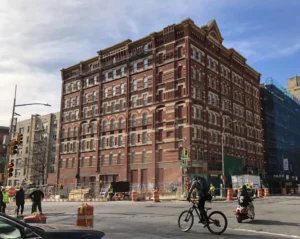
The Windermere photo courtesy of Phil O’Brien www.w42st.com
I love the old buildings and homes built in New York City from about 1880 through the 1920s. I love them for their unique, thoughtful touches in making comfortable, lovely homes. They reflect a time that can never happen again…a time of graceful living and beautiful structures. Most of these buildings and homes have been demolished to make room for skyscrapers, but a few still exist.
My old neighborhood of 57th Street between 9th and 10th Avenues has its own historical jewels. One is the apartment building where we lived when I was a little girl. It was built in 1910—and it’s still thriving. It has 10 condos for sale or rent on five floors. The units are beautiful with hardwood floors, exposed brick walls, and a kitchen with stainless steel appliances and stone counter tops. It didn’t look like that when we lived there, but it was still a great home for us.
Our apartment was on the second floor. My aunt (my mom’s sister) lived on the top floor with my uncle and two cousins. There was an awful lot of running up and down those stairs—we had a lot of fun living close together. My mom’s older sister, Aunt Augy, lived a couple of doors down from us, closer to 10th Avenue so we would go from our building to Aunt Augy’s crossing over the roofs. It was great growing up on 57th Street with all my relatives and wonderful neighbors. We looked out for each other. It was a safe, happy time.
“Googling” my old neighborhood recently, to see if any new buildings or changes were being made, I was surprised to come across the Windermere. It’s located on the corner of 57th Street and Ninth Avenue…and it’s considered an architectural historic gem.
The December 2019 issue of Forgotten New York describes the building’s “light brown brick façade with buff trim combining Queen Anne, High Victorian Gothic, and Romanesque architectural elements.”
Frankly, as a kid growing up, I never really paid attention to the Windermere. It seemed dark and scary to me—but it has quite a history! In 2005, it was granted landmark status by the Landmarks Preservation Commission, formed in 1965 to preserve and protect buildings that have special architectural, historical and cultural significance to New York City, the state or the nation.
The Windermere was built in 1881 for developer Henry Sterling Goodale as one of New York City’s first apartment buildings. It had all the technological conveniences available at that time—electrified elevators and telephone service. It offered spacious rental apartments for families and for a new phenomenon—single workingwomen: salesgirls, secretaries, artists and writers. And later in the 1950s, it was home for actor Steve McQueen.
Steve McQueen
An article written by Dana Kennedy, which appeared in the July 17, 2021 issue of the New York Post, tells the story of a group of women who fought for 40 years to save the Windermere. This began in 1980, when conditions at the Windermere were deteriorating. That’s when tenants, including Cappy Haskin (one of the last tenants to vacate the Windermere) went to former Legal Services attorney Deborah Rand for help in fighting evictions. “Even after leaving Legal Services in 1987 to work as an attorney for the city,” according to The Post, “Rand continued to advocate for Windermere tenants for the next three decades.”
The owner of the Windermere at that time wanted to get rid of the tenants who refused to move. He let conditions at the building deteriorate; he moved in pimps, prostitutes and drug dealers to force out the tenants. He hired men to harass tenants, even threatening violence (they were later imprisoned for this harassment). When the court ordered the owner to make repairs, he instead sold the building to a Japanese businessman in 1986.
“By 2007,” according to The Post, “the city ordered the last tenants, who had been there for about 40 years, to vacate because the building had become a fire hazard.“
In 2009, developer Mark Tress of Windermere Properties LLC bought The Windermere for $13 million. He plans to convert the building into a boutique hotel with ground floor retail space and a rooftop restaurant. To compensate for the harassment of tenants by a previous owner, the city requires that 20 units be set aside for affordable housing.
The Windermere has survived…thanks to a small group of die-hard tenants and attorney Deborah Rand. One of those tenants, Cappy Haskin, told The Post: “It made me feel good that we saw it through. The building survived. It was a fight not in vain. It’s pretty awful not to have a home. But something good came out of all that suffering.”
I wonder why developer Goodale built the Windermere in Hell’s Kitchen during the 1880s when it was one of the city’s toughest neighborhoods? In 1881, when gangs ruled Hell’s Kitchen, there were gruesome murders and riots. Was the cost of building the Windermere cheaper because it was such a rough neighborhood? Did Goodale believe his building—geared to families and workingwomen tenants—hope it would help change Hell’s Kitchen?
Goodale must have had a vision. And despite all the neglect and disrepair through a great many of the last 141 years, the Windermere still stands. Cherished for many years, then abandoned and allowed to deteriorate for a long time, the Windermere has survived.
And its current owner has his own vision for this architectural gem. As Tress told The Post: “It’s a big, rich part of New York City yesteryear. It’s a gem in the rough and it’s back.”
Frankly, I can’t wait to see the renovated Windermere (completion date expected by the end of 2023). Like the legendary phoenix rising from the ashes, I’m sure the Windermere will look as glorious as it did when it was built in 1881—perhaps even better.
The Windermere has proven to be as resilient as Hell’s Kitchen…survivors both.
